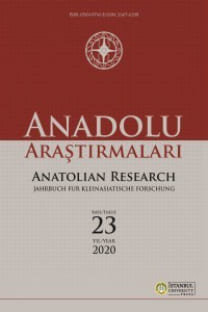NEW OBSERVATIONS OF THE DOGUBAYAZIT ROCK-CUT TOMB
Urartu, Doğubayazıt, Rock-Cut Tomb, Façade Relief
___
- Başgelen, N. 1987 “Atabindi I Kaya Mezarı Üzerine Gözlemler”, Arkeoloji ve Sanat 36-37: 8-11.
- Belck, W. 1899 “Aus der Berichten über die Armenische Expedition, Die Fels-Sculptur von Bajazed”, Zeitschrift für Ethnologie 31: 241-243.
- Biber, H. – Çavuşoğlu, R. 2013 “2011 Yılı Muş-Malazgirt Arkeolojik Yüzey Araştırması”, 30. Araştırma Sonuçları Toplantısı 2, Ankara: 303-320
- Burney, C. A. 1966 “A First Season of Excavations on the Urartian Citadel of Kayalıdere”, Anatolian Studies 16: 55-111.
- Ceylan, A. 2016 “Kuzeydoğu Anadolu Yüzey Araştırmalarında Keşfettiğimiz Kaya Mezarları”, Bengü 3: 7-67.
- Çevik, N. 2000 Urartu Kaya Mezarları ve Ölü Gömme Gelenekleri, Ankara.
- Genç, B. 2015 “Urartu ve Assur Arasındaki Kültürel İlişkiler ve Urartu’nun Dönüşümünde Assur Etkisi”, Doktora Tezi, Marmara Üniversitesi, Sosyal Bilimler Enstitüsü, Tarih Anabilim Dalı, Eskiçağ Tarihi Bilim Dalı, İstanbul
- Huff, D. 1968 “Das Felsgrab von Eski Doğubayazit”, Istanbuller Mitteilungen 18: 58-86.
- 1990 “Das grab von Doğubeyazıt. Seine stellung unter den urartäischen und iranischen felsgräbern”, X. Türk Tarih Kongresi, Ankara 22-26 Eylül 1986, Kongreye Sunulan Bildiriler I, Ankara: 87-95.
- Kellner, H. J. 1980 “Ein Neues Goldmedaillon aus Urartu”, Archäologische Mitteilungen aus Iran 13: 83-92.
- 1991 “Medallions and Pectorals”, R. Merhav (ed.), Urartu: A Metalworking Center in the First Millenium B.C.E, Jerusalem: 164-70.
- Kleiss, W. 1968 “Urartäische Plätze in Iranisch-Azerbaidjan”, Istanbuler Mitteilungen 18: 1-44.
- 1974 “Planaufnahmen Urartãischer Burgen und Neufunde Urartãischer Anlange in Iranisch-Azerbaidjan im Jahre 1973”, Archäologische Mitteilungen aus Iran 7: 79-113.
- Konyar, E. 2011 “Urartu Mezar Tipleri ve Gömü Adetleri-Tomb Types and Burial Traditions in Urartu”, K. Köroğlu, E. Konyar (eds.), URARTU: Doğuda Değişim - Transformation in the East, İstanbul: 206-231.
- Konyar, E. – Avcı, C. 2014 “Van-Tušpa Excavations 2013”, Colloquium Anatolicum XIII: 205-228.
- Köroğlu, K. 2007 “New Observations on the Origin of the Single-Roomed Rock-Cut Tombs of Eastern Anatolia”, M. Alparslan, M. Doğan-Alparslan, H. Peker (eds.), Belkıs Dinçol and Ali Dinçol’a Armağan. VITA. Festschrift in Honor of Belkıs Dinçol and Ali Dinçol, İstanbul: 445-456.
- 2008 “Urartu Kaya Mezar Geleneği ve Doğu Anadolu’daki Tek Odalı Kaya Mezarlarının Kökeni”, Arkeoloji ve Sanat 127: 21-38.
- Lehman-Haupt, C. F. 1931 Armenien Einst und Jetzt II/2, Berlin.
- Merhav, R. 1991 “Some Observations Pectorals and Medallions”, R. Merhav (ed.), Urartu: A Metalworking Center in the First Millenium B.C.E, Jerusalem: 171-76.
- Özfırat, A. 1999 “1997 Yılı Bitlis-Muş Yüzey Araştırması: Tunç ve Demir Çağları”, 16. Araştırma Sonuçları Toplantısı 16/2, Ankara:1-22.
- Piotrovsky, B. 1970 Karmir Blur, Leningrad.
- Sevin, V. 1994 “Three Urartian Rock-Cut Tombs from Palu”, Tel Aviv 21/1: 58-67.
- 2012 Van Kalesi: Urartu Kral Mezarları ve Altıntepe Halk Mezarlığı, İstanbul.
- Texier, C. 1842 Description de I’Armēnie la Perse et la Mēsopotamie, Paris.
- ISSN: 0569-9746
- Yayın Aralığı: 2
- Başlangıç: 1955
- Yayıncı: İstanbul Üniversitesi Edebiyat Fakültesi
BATHONEA. A SITE THAT NEVER EXISTED
THE EARLY NEO-ASSYRIAN PROVINCIAL ARMY OF GŪZĀNA
THE ROLE OF THE ENSLAVED POPULATIONS IN THE URARTIAN SETTLEMENT POLICY
RETHINKING: ON THE URARTIAN IVORY ARTEFACTS
NEW OBSERVATIONS OF THE DOGUBAYAZIT ROCK-CUT TOMB
URARTU KRALLIĞI’NDA HAYVANCILIĞIN SOSYO EKONOMİK ACIDAN ÖNEMİ
